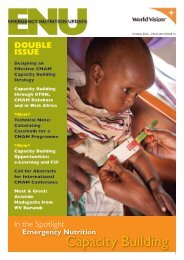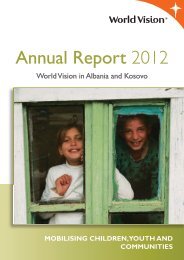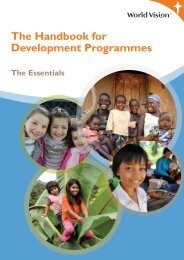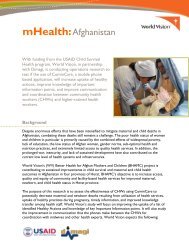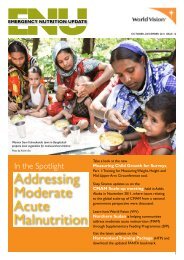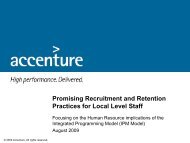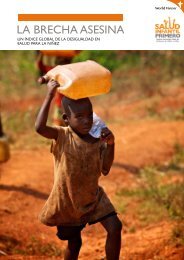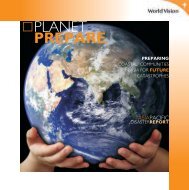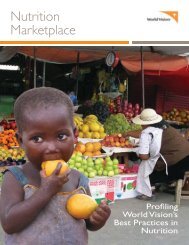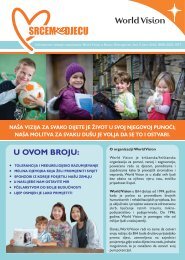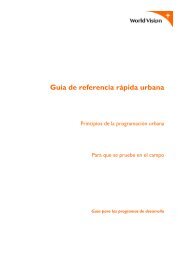download - World Vision's Nutrition Centre of Expertise
download - World Vision's Nutrition Centre of Expertise
download - World Vision's Nutrition Centre of Expertise
You also want an ePaper? Increase the reach of your titles
YUMPU automatically turns print PDFs into web optimized ePapers that Google loves.
ENU<br />
EMERGENCY NUTRITION UPDATE<br />
In the Spotlight<br />
Mental Health and<br />
Psychosocial Support<br />
in Emergency <strong>Nutrition</strong><br />
Programmes<br />
April – September 2012 ISSUE 14<br />
Women- and Infant-<br />
Friendly Spaces in<br />
Pakistan<br />
FY12 CMAM<br />
programme summary<br />
Highlights from Global<br />
IYCF-E workshop<br />
New Resources: MAM<br />
Decision Tool and<br />
CMAM Forum website<br />
Photo by Muhammad Ali/<strong>World</strong> Vision<br />
1
ENU SPOTLIGHT<br />
Mental Health and<br />
Psychosocial Support<br />
(MHPSS)<br />
Incorporating MHPSS Considerations within <strong>Nutrition</strong><br />
<strong>Nutrition</strong>al deficiencies<br />
and a lack <strong>of</strong> stimulation<br />
create a vicious cycle<br />
in which deprivation<br />
in one can result in<br />
further deprivation in<br />
the other. For example,<br />
a malnourished infant<br />
may show reduced<br />
psychomotor activity<br />
(e.g. the child is less<br />
likely to crawl and<br />
engage in creative play).<br />
As the child becomes<br />
more apathetic and<br />
less demanding, parents<br />
<strong>of</strong>ten provide less<br />
stimulation.<br />
For some time it has been recognised that adequate nutrition alone is not enough to<br />
enable a child to develop to his or her full potential. For optimal physical and cognitive<br />
development to occur, a child requires both adequate nutrition and physical and<br />
emotional stimulation from caregivers. Many <strong>of</strong> <strong>World</strong> Vision’s health and nutrition<br />
responses focus solely on providing children with nutrition inputs coupled with<br />
various health and hygiene messages. However, WHO advises that mental health and<br />
psychosocial support must be included within a nutrition response to ensure that<br />
children develop to their full potential both intellectually and physically, and do not<br />
develop lifelong disabilities as a result <strong>of</strong> nutritional deficiencies and a lack <strong>of</strong> stimulation.<br />
The first three years <strong>of</strong> life form a critical period in which the brain is developing most<br />
rapidly. During this period, it is essential that the brain receives physical stimulation<br />
through sounds, objects, touch and movement; a positive emotional attachment to a<br />
caregiver; and adequate nutrition. If these things are not provided, a child’s brain can<br />
develop abnormally, leading to mental disability and vulnerability to mental illness later in<br />
life. During a food crisis, it is even more vital that such concerns are considered. A child<br />
experiencing nutritional deficiencies may show reduced activity and become apathetic.<br />
Therefore, the caregiver may reduce the amount <strong>of</strong> stimulation provided to the child as<br />
the child stops responding to the caregiver, leading to permanent developmental delays<br />
and vulnerability to mental health issues (WHO, 2007).<br />
Lack <strong>of</strong><br />
nutritious food<br />
Malnutrition<br />
Severe food<br />
shortage<br />
Poor health<br />
Insufficient<br />
care/stimulation<br />
Psychosocial<br />
deprivation<br />
Submitted by Megan<br />
McGrath, Mental Health<br />
and Psychosocial Support<br />
Coordinator, Humanitarian<br />
and Emergency Affairs, <strong>World</strong><br />
Vision Australia<br />
Developmental delays/mental health problems<br />
Source: WHO, Mental health and psychosocial well-being among children in severe food shortage, 2007.<br />
2
In addition, a caregiver’s mental health also has an impact on his or her ability to feed<br />
and adequately care for a child. Research into mothers experiencing depression showed<br />
a strong link between depression and a mother ceasing to breastfeed her infant. In<br />
addition, a caregiver experiencing depression is less likely to be able to emotionally<br />
and physically stimulate his or her child. Approximately 40% <strong>of</strong> women in developing<br />
countries are likely to experience post-natal depression (Cooper, et al, 1999). Therefore,<br />
support should be provided to mothers within a nutrition programme to reduce<br />
depressive symptoms and thus enable each mother to provide adequate care to her<br />
child.<br />
Research suggests that combining nutritional programmes with support for positive<br />
parenting and stimulation have a long-term effect on a child’s mental health. In a study<br />
on the impact <strong>of</strong> providing food supplements and stimulation to stunted and nonstunted<br />
9-24 month old children in Jamaica, the stunted children who received both<br />
interventions weekly over a two-year period had higher developmental scores than<br />
those who received neither intervention, or only the nutrition intervention (Walker,<br />
Chang, Powell, Grantham-McGregor, 2005).<br />
Integrating such interventions at the field level is not a difficult task. For example, within<br />
the Supplementary Feeding Programme in Darfur, Sudan, <strong>World</strong> Vision has included a<br />
women- and infant-friendly space in which caregivers can meet, receive support from<br />
each other, and be provided with messages and examples <strong>of</strong> how to emotionally and<br />
physically stimulate their children. Such examples include talking to the child, looking<br />
into the child’s eyes, smiling, playing games with the child, telling stories and making<br />
toys out <strong>of</strong> local materials. Support is provided to mothers showing signs <strong>of</strong> distress<br />
or depression through an approach known as ‘Psychological First Aid’ (PFA). PFA is a<br />
humane, supportive response to a fellow human being who is suffering and who may<br />
need support. PFA includes the following themes: providing practical care and support<br />
that is not intrusive; assessing needs and concerns; helping people to access basic needs<br />
(e.g. food and water, information); comforting people and helping them to feel calm;<br />
helping people connect to information, services and social supports; and protecting<br />
people from further harm (IASC, 2007).<br />
An integrated nutrition and stimulation programme that emphasises both appropriate<br />
feeding practices and responsive parenting has a greater impact than either intervention<br />
alone. <strong>Nutrition</strong> programmes that contain both positive stimulation and support for<br />
caregivers are more effective in promoting growth and positive child development than<br />
nutrition programmes without a psychosocial component.<br />
References:<br />
Cooper PJ, Tomlinson M, Swartz L (1999). Post-partum depression and the mother-infant<br />
relationship in a South African peri-urban settlement. Br. J. Psychiatry; 175:554–558<br />
Inter-Agency Standing Committee (IASC) (2007). IASC guidelines on mental health and<br />
psychosocial support in emergency settings. Geneva: IASC.<br />
Walker S, Chang S, Powell C, Grantham-McGregor S (2005). Effects <strong>of</strong> early childhood<br />
psychosocial stimulation and nutritional supplementation on cognition and education in growthstunted<br />
Jamaican children: prospective cohort study. Lancet, 366: 1804–1807.<br />
<strong>World</strong> Health Organization(WHO) (2006). Mental health and psychosocial well-being<br />
among children in severe food shortage. WHO.<br />
Photo by Muhammad Ali/<strong>World</strong> Vision<br />
3
Incorporating<br />
MHPSS<br />
Considerations<br />
within <strong>Nutrition</strong><br />
Programmes<br />
The important role <strong>of</strong> psychosocial stimulation in the rehabilitation<br />
<strong>of</strong> children with acute malnutrition has long been recognised.<br />
Historically, residential treatment facilities for acute malnutrition<br />
where children remained for one month provided a good setting to<br />
incorporate psychosocial interventions and training for caregivers<br />
on this essential component <strong>of</strong> child development. With the shift<br />
to decentralised treatment for acute malnutrition through CMAM<br />
programmes, psychosocial support and stimulation interventions<br />
are <strong>of</strong>ten overlooked.<br />
Interventions to provide emotional and psychosocial stimulation to<br />
children have been identified; however, how to effectively integrate<br />
these interventions within the context <strong>of</strong> CMAM and other nutrition<br />
programming given the operational constraints, such as limited staff,<br />
high number <strong>of</strong> beneficiaries and decentralised programme sites, is<br />
not well understood.<br />
Emotional stimulation:<br />
Interventions to improve childcaregive<br />
interactions are important<br />
in order to facilitate children’s<br />
emotional, social and language<br />
development.<br />
Educate caregivers on the<br />
importance <strong>of</strong> emotional<br />
communication.<br />
Physical Stimulation:<br />
Children need a physically<br />
stimulating environment in order<br />
to develop their psychomotor<br />
and language skills and to enhance<br />
cognitive development.<br />
Express warmth and affection to the<br />
child in a manner consistent with<br />
cultural norms<br />
Encourage verbal and non-verbal<br />
communication between the child<br />
and caregiver<br />
Respond to the needs <strong>of</strong> the child<br />
Show appreciation for what the child<br />
manages to do<br />
Ensure that the environment<br />
provides adequate sensory<br />
experiences for the child<br />
Provide play materials<br />
Encourage caregivers to look into the child’s eyes and smile<br />
at him or her, especially during breastfeeding. Express physical<br />
affection to the child<br />
Communicate with the child as much as possible. Ask the child<br />
simple questions and respond to his or her attempts to talk. Try<br />
to get a conversation going with sounds and gestures (smiles,<br />
glances). Get the child to laugh and vocalise. Teach the child<br />
‘action words’ with activities. For example, say ‘bye’ when waving<br />
goodbye.<br />
Respond to the child’s sounds and interests. Be attentive to his<br />
or her needs as indicated by his or her verbal or non-verbal cues<br />
(e.g. crying, smiling).<br />
Provide verbal praise for the child’s accomplishments. Also, show<br />
non-verbal signs <strong>of</strong> appreciation and approval (e.g. clapping,<br />
smiling).<br />
Provide ways for children to see, hear and move. For example,<br />
place colourful objects around the child and encourage the<br />
child to reach or crawl to them. Sing local songs and play games<br />
involving fingers and toes.<br />
Inexpensive and fun toys such as a puzzle and a rattle can be<br />
made out <strong>of</strong> cardboard boxes and plastic bottles.<br />
Provide meaning to the child’s<br />
physical world<br />
Provide opportunities to practice<br />
skills<br />
Help the child to name, count and compare objects.<br />
Older children can sort objects by colour and learn concepts<br />
such as ‘high’ and ‘low’. Describe to the child what is happening<br />
around them.<br />
It is important to play with each child individually at least 15–30<br />
minutes per day, as well as to provide opportunities for play with<br />
other children.<br />
Opportunities for <strong>World</strong> Vision<br />
• Include psychosocial stimulation interventions in nutrition programmes and implement and document your experience in order to share<br />
learnings.<br />
• In large-scale emergencies, women- and infant-friendly spaces (WAIFS) or baby-friendly areas can provide opportunities to include<br />
MHPSS interventions. See <strong>World</strong> Vision’s guidance on supporting breastfeeding in emergencies through the use <strong>of</strong> baby-friendly tents<br />
(http://www.wvnutrition.net/home/resources/guidelines/breastfeeding-in-emergencies.html). For more information on WAIFS contact<br />
Claire Beck claire_beck@wvi.org.<br />
4
Women- and Infant-Friendly<br />
Spaces (WAIFS) in Pakistan<br />
<strong>World</strong> Vision is implementing 16 Women- and Infant-Friendly Spaces (WAIFS) in three<br />
provinces in Pakistan. The purpose <strong>of</strong> WAIFS is to provide a space where a woman and<br />
her child feel safe and comfortable, participate in structured activities and experience<br />
healing from any trauma and loss they have experienced.<br />
A variety <strong>of</strong> services are provided at the WAIFS, including:<br />
• Psychosocial support to women in<br />
psychological distress<br />
• Screening <strong>of</strong> children 6 months to 59<br />
months for malnutrition and referral<br />
to nutrition clinics<br />
• Screening <strong>of</strong> pregnant and lactating<br />
women for malnutrition and referral<br />
to nearest health facility<br />
• Health and hygiene education sessions<br />
on common diseases, environmental<br />
health and prophylactic measures<br />
• Awareness and education on correct<br />
breastfeeding technique<br />
• Health education on birth spacing<br />
and modern and conventional<br />
contraceptive methods<br />
• Awareness on gender issues, such<br />
as domestic violence, gender-based<br />
violence, seeking reproductive health<br />
services, sexual abuse.<br />
• Empowering women through skills<br />
development, such as sewing and<br />
embroidery, and coaching and<br />
guidance on educational needs<br />
• New birth registration<br />
• Celebrating national and international<br />
events, such as International Women’s<br />
Day and <strong>World</strong> Breastfeeding Week<br />
WAIFS provide a platform for women <strong>of</strong> different ethnic and tribal backgrounds to<br />
come together, thereby promoting understand and harmony among different groups.<br />
It is also a forum to discuss sensitive social and domestic issues and provides a social<br />
outlet for women who are <strong>of</strong>ten isolated.<br />
Challenges<br />
Although WAIFS are transitional supports, contributing to the short- to mediumterm<br />
relief effort, there is a risk that organisations fail to consider issues <strong>of</strong> transition<br />
and sustainability. Past experiences show that meaningful community participation<br />
in the planning, design and operational stages <strong>of</strong> WAIFS has been weak. As a result,<br />
getting community understanding, acceptance and meaningful participation was initially<br />
challenging.<br />
The way forward<br />
After the emergency phase, WAIFS can become a sustainable programme if community<br />
volunteers are trained to take over the activities. <strong>World</strong> Vision Pakistan envisions<br />
WAIFS as centres <strong>of</strong> innovation and creativity, including a mini-library and kitchen<br />
gardening activities. Such centres also provide the opportunity to integrate child<br />
protection, health, nutrition, livelihoods, education, advocacy, and water, sanitation and<br />
hygiene sectors.<br />
Submitted by<br />
Dr. Rasheed Ahmed<br />
Photo by<br />
Mahammad Ali<br />
WAIFS<br />
Women- and infant-friendly spaces is<br />
one approach used to ensure support<br />
to mothers and breastfeeding women.<br />
It provides a safe place for young<br />
children and mothers immediately<br />
after an emergency. WAIFS (or similar<br />
spaces) have been used by many<br />
organisations (UNICEF, SAVE, ACF) in<br />
emergencies and should be part <strong>of</strong><br />
<strong>World</strong> Vision’s early response in an<br />
emergency. <strong>World</strong> Vision operational<br />
guidelines for WAIFS are forthcoming.<br />
5
NEWS FROM THE FIELD<br />
Photo by Megan McGrath<br />
<strong>World</strong> Vision’s Megan McGrath was seconded as a consultant to UNICEF<br />
in July 2012, to ensure the inclusion <strong>of</strong> mental health and psychosocial<br />
support in the West African region’s response. The purpose <strong>of</strong> this<br />
consultancy was to develop a strategy <strong>of</strong> interventions on providing<br />
emotional/psychosocial stimulation to children and their caregivers and to<br />
strengthen the capacity <strong>of</strong> partners to initiate such activities within their<br />
nutritional and conflict responses in five countries in the region (Burkina<br />
Faso, Niger, Mauritania, Chad<br />
and Senegal). As part <strong>of</strong><br />
Integrating Mental Health<br />
and Psychosocial Support<br />
into the Sahel <strong>Nutrition</strong><br />
and Refugee Crisis<br />
this consultancy, a series <strong>of</strong><br />
six training sessions were<br />
provided on the following<br />
topics: Demystifying MHPSS,<br />
Infant and Child MHPSS<br />
in <strong>Nutrition</strong> Programmes,<br />
Maternal Mental Health,<br />
Psychological First Aid, MHPSS<br />
in Formal and Non-formal<br />
Education, MHPSS in Child Protection. Along with other partners, <strong>World</strong><br />
Vision staff from Niger, Chad and Senegal attended these trainings.<br />
In order to practise emotional and physical stimulation techniques,<br />
participants learned how to make a woollen doll, and then used the dolls<br />
to practise various emotional and physical stimulation techniques using the<br />
WHO Mental Health in Food Shortages intervention table (2007) and the<br />
UNICEF Care for Development Counselling Cards.<br />
6
CMAM Update for FY12 (October 1, 2011–September 30, 2012)<br />
Country<br />
Chad<br />
S. Sudan<br />
Kenya<br />
Ethiopia<br />
Somalia<br />
Niger<br />
WCRC<br />
Burundi<br />
Mali<br />
Pakistan<br />
Sierra Leone<br />
Mauritania*<br />
Tonj South,<br />
Tonj North and<br />
Gogrial West<br />
10 2<br />
2 regions –<br />
Punjab, Sindh<br />
1 health<br />
district<br />
13 22 1 17 16 4<br />
4<br />
Project<br />
areas / ADPs<br />
covered<br />
New projects<br />
in Tonj East and<br />
Gogrial East<br />
OTP= 61<br />
OTP=45<br />
OTP=41<br />
OTP=12<br />
OTP= 16<br />
OTP=45<br />
OTP=15<br />
SFP=60<br />
OTP=6<br />
SFP=31<br />
SFP=21<br />
NA NA<br />
SFP=1<br />
OTP=24 OTP=13<br />
SFP= 167<br />
SFP=37<br />
SFPPLW=22<br />
SC=86<br />
SFPPLW=63<br />
SC=1<br />
SFPPLW=30<br />
SFPPLW=4<br />
Total number<br />
<strong>of</strong> sites<br />
SC=2<br />
SFPPLW=142<br />
SC=5<br />
SFP=551<br />
SC=4<br />
SC=10<br />
SC=7<br />
OTP=10311<br />
OTP= 1091<br />
OTP= 6919<br />
OTP=233<br />
OTP=1637<br />
OTP=442<br />
OTP=7788<br />
OTP=4057<br />
SFP=25167<br />
OTP=248***<br />
SFP=7334<br />
SFP=4978<br />
OTP=2338<br />
SC=86 SFP=551<br />
Number<br />
admitted<br />
SFP=1019<br />
SFP=4224<br />
SFP=NA<br />
SFP=29018<br />
OTP=2176<br />
OTP= 4393<br />
SFP=11895<br />
SFPPLW=5929<br />
SFP= 9187<br />
SFPPLW=17649<br />
SC=7<br />
SFPPLW=3718<br />
SFPPLW=291<br />
SC=2<br />
SC=132<br />
SC=NA<br />
SC=113<br />
SC=1306<br />
SC=168<br />
SC=562<br />
SFPPLW=2346<br />
SC=557<br />
No RUTF stock<br />
available March<br />
to July<br />
Oct1, 2011<br />
to Sept 30,<br />
2012<br />
OTP=83.1%<br />
SFP=95.4%<br />
OTP=95.9%<br />
SFP=98.9%<br />
OTP=96%<br />
SFPPLW=98.9%<br />
SC=97.3%<br />
OTP=89.6%<br />
SFP=92.3%<br />
OTP=82.8% 31.9%***<br />
SFPPLW=99.2%<br />
SC=87.6%<br />
OTP=93.7%<br />
SFP=97.2%<br />
OTP=98.4%<br />
OTP=93.4%<br />
SC=89.7%<br />
OTP=82.9%<br />
SFP=86.8%<br />
SFPPLW=82.4%<br />
OTP=75.9%<br />
SFP=89.8%<br />
Recovered OTP=56.5%**<br />
SFPPLW=83.7%<br />
SC=78.6%<br />
OTP=0%<br />
OTP=0.6%<br />
OTP=1.3%<br />
OTP=0.6%<br />
OTP=2.2%<br />
SFP=0%<br />
SFP=0%<br />
OTP=
Research Updates<br />
Cost-Effectiveness <strong>of</strong> CMAM by<br />
Community Health Workers in<br />
Southern Bangladesh<br />
This study assessed the cost-effectiveness <strong>of</strong> adding the community-based<br />
management <strong>of</strong> severe acute malnutrition (CMAM) to a community-based<br />
health and nutrition programme delivered by community health workers<br />
(CHWs) in southern Bangladesh. The cost-effectiveness <strong>of</strong> communitybased<br />
treatment <strong>of</strong> severe acute malnutrition (SAM) was compared with<br />
the cost-effectiveness <strong>of</strong> the ‘standard <strong>of</strong> care’ for SAM, that is, inpatient<br />
treatment, augmented with community surveillance by CHWs to detect<br />
cases.<br />
The community-based strategy cost US$26 per disability-adjusted life<br />
year (DALY) averted, compared with US$1,344 per DALY averted for<br />
inpatient treatment. The average cost to participant households for<br />
their child to recover from SAM in community treatment was one-sixth<br />
that <strong>of</strong> inpatient treatment. These results suggest that this model <strong>of</strong><br />
treatment for SAM is highly cost-effective and that CHWs, given adequate<br />
supervision and training, can be employed effectively to expand access to<br />
treatment for SAM in Bangladesh.<br />
Puett C, Sadler K, Alderman H, Coates J,<br />
Fiedler JL, Myatt M. (2012). Cost-effectiveness<br />
<strong>of</strong> the community-based management <strong>of</strong> severe<br />
acute malnutrition by community health workers<br />
in southern Bangladesh. Health Policy Plan.<br />
What are DALYs?<br />
A Disability-Adjusted Life Year<br />
(DALY) is a measure <strong>of</strong> overall<br />
disease burden. One DALY can<br />
be thought <strong>of</strong> as one lost year <strong>of</strong><br />
‘healthy’ life. The sum <strong>of</strong> these<br />
DALYs across the population can<br />
be thought <strong>of</strong> as a measurement<br />
<strong>of</strong> the gap between current health<br />
status and an ideal health situation<br />
where the entire population<br />
lives to an advanced age, free <strong>of</strong><br />
disease and disability.<br />
Source: WHO<br />
Identifying children at high risk <strong>of</strong> mortality due to<br />
malnutrition – weight-for-height or MUAC?<br />
Briend A, Maire B, Fontaine O, Garenne M. (2012). Mid-upper arm circumference and weight-for-height to identify high-risk<br />
malnourished under-five children. Matern Child Nutr 8(1): 130-133.<br />
Photo by Muhammad Ali/<strong>World</strong> Vision<br />
Severe acute malnutrition(SAM) (nonoedematous)<br />
in children under 5 years <strong>of</strong><br />
age is defined by WHO and UNICEF as<br />
a mid-upper arm circumference (MUAC)<br />
less than 115 mm or by a weight-for-height<br />
z-score (WHZ) less than -3. Children with<br />
SAM are at high risk <strong>of</strong> death; up to 20<br />
times higher than a well-nourished child<br />
(WHO). The objective <strong>of</strong> the study was<br />
to assess whether there was any benefit<br />
to identify malnourished children with<br />
a high risk <strong>of</strong> death by combining these<br />
two diagnostic criteria—MUAC and<br />
weight-for-height. Data <strong>of</strong> a longitudinal<br />
study examining the relationship between<br />
anthropometry and mortality in rural<br />
Senegal and predating the development<br />
<strong>of</strong> community-based management <strong>of</strong> SAM<br />
were used for this study. The study found<br />
that MUAC identifies high-risk children<br />
better than WHZ. It concluded that to<br />
identify high-risk malnourished children,<br />
there is no benefit in using both WHZ less<br />
than -3 and/or MUAC less than 115 mm,<br />
and that using MUAC alone is preferable.<br />
8
Tools, Guidelines and Recommendations<br />
MAM<br />
Decision<br />
Tool<br />
available<br />
The MAM Taskforce, a working<br />
group made up <strong>of</strong> cluster partners<br />
and led by UNICEF, developed a<br />
decision tool to support emergency<br />
practitioners in deciding which type<br />
<strong>of</strong> intervention is most appropriate<br />
for the prevention and treatment <strong>of</strong><br />
moderate acute malnutrition. The<br />
tool provides guidance on what type<br />
<strong>of</strong> programme, for whom, for how<br />
long and contains a useful product<br />
information sheet describing the<br />
various food types e.g. RUFs, blended<br />
foods and LNS that may be used in<br />
MAM programming. Feedback on the<br />
usefulness <strong>of</strong> this tool is welcome.<br />
Please provide your comments to<br />
colleen_emary@worldvision.ca<br />
http://oneresponse.info/<br />
GlobalClusters/<strong>Nutrition</strong>/<br />
publicdocuments/MAM%20<br />
DecisionTool%20July%202012%20<br />
with%20Cover.pdf<br />
CMAM FORUM<br />
Website has launched!<br />
The CMAM Forum was established in 2012 by a group <strong>of</strong> experts with the aim to provide<br />
a robust information-sharing mechanism that expands the knowledge base on acute<br />
malnutrition to improve health outcomes for vulnerable populations. It will build upon and<br />
link with existing initiatives. Specific objectives are to:<br />
1. Facilitate information and resources sharing on the management <strong>of</strong> acute malnutrition<br />
2. Promote and support advocacy efforts on the management <strong>of</strong> acute malnutrition<br />
The CMAM Forum is a ‘one-stop shop’ for everything related to acute malnutrition. Training<br />
materials, including video, technical resources and updates, as well as country-specific<br />
protocols and advocacy materials are available on this site. Check out the website and join<br />
the CMAM Forum today. http://www.cmamforum.org/<br />
New SMART<br />
website launched in<br />
English, French and Spanish<br />
SMART (Standardized Monitoring and Assessment <strong>of</strong> Relief and Transitions) is an interagency<br />
initiative launched in 2002 by a network <strong>of</strong> organisations and humanitarian<br />
practitioners. SMART Methodology is an improved survey method that balances simplicity<br />
(for rapid assessment <strong>of</strong> acute emergencies) and technical soundness. It draws from the<br />
core elements <strong>of</strong> several methodologies with continuous upgrading informed by research<br />
and current best practices. The new user-friendly website, featuring SMART capacity building<br />
tools, FAQs and a discussion forum, is managed by Action Against Hunger Canada and was<br />
launched in July 2012. http://smartmethodology.org/<br />
9
Research and Global Participation<br />
Workshop<br />
Debrief:<br />
Strengthening<br />
Infant and Young<br />
Child Feeding<br />
Programming<br />
and Planning<br />
for Emergency<br />
Preparedness and<br />
Response<br />
June 25th to 29th, 2012,<br />
London, UK<br />
Meeting Report Prepared by: Sisay<br />
Sinamo, <strong>Nutrition</strong> Advisor, EARO and<br />
Colleen Emary, Emergency <strong>Nutrition</strong><br />
Technical Advisor, NCoE<br />
The purpose <strong>of</strong> the workshop was to strengthen infant and young child feeding (IYCF)<br />
and infant and young child feeding in emergency (IYCF-E) in programming and planning for<br />
emergency preparedness and response both in developmental and emergency contexts. The<br />
workshop was organised by Save the Children UK in collaboration with UNICEF and Global<br />
<strong>Nutrition</strong> Cluster. It was held in London, UK from June 25–29, 2012. Over sixty delegates<br />
from the UN family (UNICEF and FAO), international NGOs, donors, universities and Ministry<br />
<strong>of</strong> Health participated in the workshop. Workshop proceedings are now available. http://www.<br />
unicef.org/nutritioncluster/files/IYCF_-_IYCF-E_workshop_report_2012.pdf<br />
The workshop identified the following key constraints to IYCF/IYCF-E<br />
programming:<br />
• Poor understanding <strong>of</strong> indicators<br />
• Lack <strong>of</strong> dedicated funding<br />
• No policy / policy not implemented<br />
• Lack <strong>of</strong> knowledge / understanding <strong>of</strong> what is good programming<br />
• Few trained frontline staff<br />
• Urgent need for a IYCF-E How To guide for different contexts<br />
• Lack <strong>of</strong> global leadership for IYCF-E<br />
The key lessons relevant for <strong>World</strong> Vision nutrition programmes at regional and<br />
national level are summarised as follows:<br />
• Work with the Humanitarian and Emergency Affairs (HEA) and People & Culture to<br />
include IYCF-E in the staff orientation package before emergency programme deployment<br />
to address issues related to feeding practices that could arise during emergency response,<br />
including orientation to <strong>World</strong> Vision’s Milk Policy and the Operational Guidance<br />
on Infant Feeding in Emergencies<br />
• Collaborate with HEA to ensure emergency programme assessment tools include IYCF/<br />
IYCF-E indicators to identify the gaps and appropriately inform emergency preparedness<br />
and response plan<br />
• Support NOs to strengthen the collaboration with nutrition cluster coordination at the<br />
country level to access technical and financial resources that will leverage programmes<br />
• Collaborate with the Communications and HEA teams to coordinate and harmonise IYCF<br />
messages and <strong>World</strong> Vision Milk Policy communication during emergency<br />
To address the global leadership gap on this issue it was proposed that a consortium <strong>of</strong><br />
interested partners, such as IFE Core Group, NGOs, UNICEF, Global <strong>Nutrition</strong> Cluster<br />
and academics, unite to move this agenda forward. <strong>World</strong> Vision will be following the global<br />
developments on this issue.<br />
The Next<br />
ENU<br />
If you have any<br />
suggestions, stories or<br />
reports which you think<br />
would be helpful for ENU<br />
readers, please email to<br />
loria_kulathungam@<br />
worldvision.ca<br />
by February 8, 2013<br />
Global Health & WASH<br />
<strong>Nutrition</strong> <strong>Centre</strong> <strong>of</strong> <strong>Expertise</strong><br />
WE ARE ALWAYS<br />
LOOKING<br />
for WV emergency nutrition staff to pr<strong>of</strong>ile in ENU.<br />
All you have to do is send an<br />
email to loria_kulathungam@<br />
worldvision.ca with answers to<br />
the following questions and a<br />
pr<strong>of</strong>ile picture <strong>of</strong> yourself.<br />
Name<br />
Years with WV<br />
Current position<br />
Current work location<br />
Main work responsibilities/<br />
activities<br />
Best part <strong>of</strong> your job/working in<br />
emergencies<br />
When you’re not working, what<br />
do you enjoy doing?<br />
For questions or contributions to the WV ENU,<br />
please contact the WV <strong>Nutrition</strong> <strong>Centre</strong> <strong>of</strong> <strong>Expertise</strong><br />
loria_kulathungam@worldvision.ca<br />
NCoE is hosted by WVCanada.<br />
10



